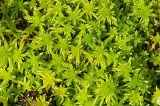
Sphagnum
Overview
Sphagnum is a genus
of between 151 and 350 species
of moss
es commonly called peat moss, due to its prevalence in peat
bog
s and mires. A distinction is made between sphagnum moss, the live moss growing on top of a peat bog on one hand, and sphagnum peat moss (North American usage) or sphagnum peat (British usage) on the other, the latter being the decaying matter underneath. Bogs are dependent on precipitation as their main source of nutrients, thus making them a favourable habitat for sphagnum as it can retain water and air quite well.
Genus
In biology, a genus is a low-level taxonomic rank used in the biological classification of living and fossil organisms, which is an example of definition by genus and differentia...
of between 151 and 350 species
Species
In biology, a species is one of the basic units of biological classification and a taxonomic rank. A species is often defined as a group of organisms capable of interbreeding and producing fertile offspring. While in many cases this definition is adequate, more precise or differing measures are...
of moss
Moss
Mosses are small, soft plants that are typically 1–10 cm tall, though some species are much larger. They commonly grow close together in clumps or mats in damp or shady locations. They do not have flowers or seeds, and their simple leaves cover the thin wiry stems...
es commonly called peat moss, due to its prevalence in peat
Peat
Peat is an accumulation of partially decayed vegetation matter or histosol. Peat forms in wetland bogs, moors, muskegs, pocosins, mires, and peat swamp forests. Peat is harvested as an important source of fuel in certain parts of the world...
bog
Bog
A bog, quagmire or mire is a wetland that accumulates acidic peat, a deposit of dead plant material—often mosses or, in Arctic climates, lichens....
s and mires. A distinction is made between sphagnum moss, the live moss growing on top of a peat bog on one hand, and sphagnum peat moss (North American usage) or sphagnum peat (British usage) on the other, the latter being the decaying matter underneath. Bogs are dependent on precipitation as their main source of nutrients, thus making them a favourable habitat for sphagnum as it can retain water and air quite well.
Unanswered Questions

